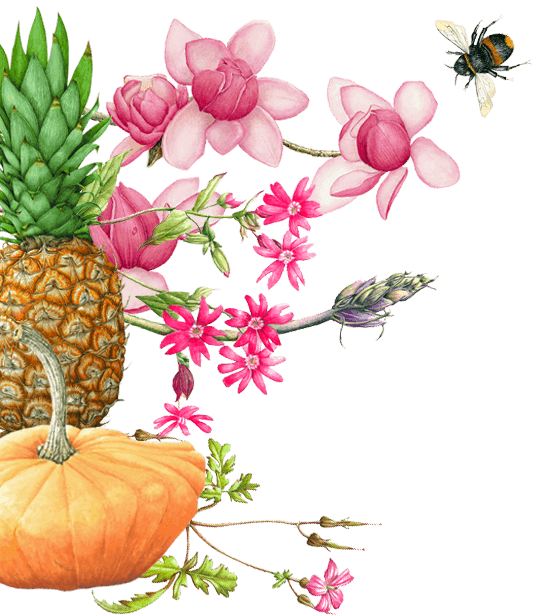The Lost Art of Seed Saving – ‘Preserving the past to protect the future’
- 28th Aug 2019
Nestled in the heart of the Heligan Productive Gardens is a cool, dry storage shed where carefully labelled pots and jars display a bounty of seeds; all lovingly collected, dried and stored by the Heligan Gardening Team. If you are lucky enough to step inside, it feels like you have happened across an Aladdin’s Cave, bursting with precious and eye-catching ‘gems’.
Seed saving would have once been an annual activity in all gardens, but one that has sadly been lost to the commerciality of time and the mass production of seeds.
The Lost Gardens have become ‘seed guardians’ for the Heritage Seed Library and have grown a bi-coloured flowering, purple variety of pea called ‘Commander’ that dates back to 1900; especially for the purpose of saving the seed.
According to the Heligan gardeners, it has actually been quite hard to not pick the peas, as the ‘Commander’ is noted for its delicious sweet taste!
However, saving, collecting and sharing seed is in fact the only way to preserve heritage varieties that are no longer commercially available.
The lost art of seed saving perfectly embodies the Heligan ethos of ‘preserving the past to protect the future”.
And here is the good news, it actually quite an easy endeavour to save certain seeds, eg tomatoes, peas and lettuce, as they generally don’t cross pollinate and you can therefore keep growing a tried and tested variety, year after year, at no extra cost!
In addition, some varieties of pea can actually adapt to your specific locality and its conditions. This means that after a couple of years you have created and preserved a strong and successful pea specific to your area!
Heligan Top Tips for Pea Seed Saving:
- Collect your seed from a minimum of two (and up to ten) of your strongest plants to ensure a good genetic representation.
- Whilst growing, check plants for any growth abnormalities and rogue out any discovered asap.
- Give yourself a long growing season so that your pods have the best opportunity to mature and dry naturally.
- If you are experiencing a wet end to the summer/autumn then you can lift the whole plant from the soil to hang inside to dry.
- Once seed pods are dry, remove from the plant and place on a single mesh drying rack or somewhere that they have plenty of space around for airflow and are not on top of each other. Leave them to dry in their pods indoors for 1-2 weeks.
- Now you can pod your seeds, checking for abnormalities and any signs of pea moth (dusty residue on seed surface) Discard any abnormal shaped or looking seed.
- Dry seeds in a single layer with good airflow for a further week or until they pass the ‘nail test’. Press the edge of your nail against the seed, if it creates an impression then the seed is not quite dry enough.
- Once your seeds are finally dry, store in a jar in a cool, dry place and remember to label and date.
- Store your seeds in a mouse free location else all of your horticultural gems might disappear in the night!
- Seed Circles: If you are able to join a local seed group it means that you are able to get your hands on some different varieties that someone else has tried and tested. Word of mouth recommendation is arguably the best way to try new and exciting flavours and varieties.
Heligan Peas, Bean & Tomato currently being saved for seed . . .
Pea ‘Commander’
Dating from the early 1900s. Originating in the Netherlands this pea is excellent for cooking and drying. Strong, tall plants (>2m) produce stunning bi-coloured flowers and purple pods with around 7 peas in each.
Pea ‘Veitch’s Perfection’
Thought to have been developed by Veitch’s Nurseries of Exeter and Chelsea, this variety is referred to in Johnson’s Hardeners’ Dictionary (1842 edition). It is a late variety producing vigorous plants (1.2 – 1.8m) plants with very large leaves whit e flowers. The large pods contain 9-11 marrowfat type peas with strong but sweet flavour.
Dwarf French Bean ‘Magpie’
A rare heirloom introduced from France in 1913 by Carter’s Seed Company. This late variety producing strong plants with white flowers and a good yield. The slim pencil pods are best eaten young, however they can also be allowed to dry when the attractive bi-coloured black and white seeds are ideal for soups and stew. Sow to harvest in approximately 90 days (approx.).
Tomato ‘Yellow Plum Formed’
Indeterminate. Cordon. Donated to HSL by William Woys Weaver, this old variety is described in the USA publication ‘The Magazine of Horticulture’, Botany & all Useful Discoveries & Improvements in Rural Affairs’ (1867) as “very handsome”. It is prolific producer of small, yellow, oval-shaped fruits with a lovely sweet and mild flavour.






